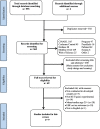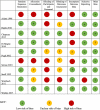Interventions to promote exclusive breastfeeding among young mothers: a systematic review and meta-analysis
- PMID: 33256788
- PMCID: PMC7706026
- DOI: 10.1186/s13006-020-00340-6
Interventions to promote exclusive breastfeeding among young mothers: a systematic review and meta-analysis
Abstract
Background: Exclusive breastfeeding rates in many high-income countries are considerably lower than the World Health Organization recommendations. Younger mothers are less likely than older mothers to exclusively breastfeed or to exclusively breastfeed for a long duration. This systematic review explores interventions to increase the rate of exclusive breastfeeding among young mothers in high-income countries.
Methods: A systematic search of the following databases was completed in August 2020: CINAHL, PubMed, MEDLINE, ProQuest, PsychInfo, Web of Science, Cochrane, Scopus and Embase. A manual search of the reference lists of all the included studies and published systematic reviews was also performed. The Cochrane Collaboration Risk of Bias Tool was used to assess the quality of the included studies. A random effects model meta-analyses was applied. Heterogeneity of outcomes between the studies was assessed using both the χ2 test and the I2 statistic.
Results: Of 955 records identified in the search, 392 duplicates were removed, and nine studies met the inclusion criteria. Seven studies were randomised controlled trial (RCTs) and two were quasi-experimental in design. Eight were conducted in the United States. The interventions included peer counselling, telephone support, massage, gift packs, financial incentive and antenatal education. Most studies included a combination of strategies, peer counselling being the most common. A meta-analysis of four of nine included studies did not detect a difference in rate of exclusive breastfeeding to 3 months postpartum (RR 1.44; 95% CI 0.82, 2.55; p = 0.204). This review is limited by the relatively few studies which met the inclusion criteria and the small sample sizes of most included studies. High rates of attrition and formula supplementation among the participants made it difficult to detect a statistically significant effect. Consistency in follow up times would enable more studies to be included in a meta-analysis.
Conclusions: Peer counselling was the most promising strategy associated with higher rates of exclusive breastfeeding. However, further studies are needed to understand the breastfeeding experiences of young mothers. Young mothers should be targeted specifically in intervention studies.
Keywords: Exclusive breastfeeding; High income countries; Interventions; Systematic review; Young mothers.
Conflict of interest statement
The authors declare that they have no competing interests.
Figures





Similar articles
-
Interventions for supporting the initiation and continuation of breastfeeding among women who are overweight or obese.Cochrane Database Syst Rev. 2019 Sep 17;9(9):CD012099. doi: 10.1002/14651858.CD012099.pub2. Cochrane Database Syst Rev. 2019. PMID: 31529625 Free PMC article.
-
Primary Care Interventions to Support Breastfeeding: Updated Systematic Review for the U.S. Preventive Services Task Force [Internet].Rockville (MD): Agency for Healthcare Research and Quality (US); 2016 Oct. Report No.: 15-05218-EF-1. Rockville (MD): Agency for Healthcare Research and Quality (US); 2016 Oct. Report No.: 15-05218-EF-1. PMID: 27854403 Free Books & Documents. Review.
-
Schedules for home visits in the early postpartum period.Cochrane Database Syst Rev. 2021 Jul 21;7(7):CD009326. doi: 10.1002/14651858.CD009326.pub4. Cochrane Database Syst Rev. 2021. PMID: 34286512 Free PMC article.
-
Counselling interventions to enable women to initiate and continue breastfeeding: a systematic review and meta-analysis.Int Breastfeed J. 2019 Oct 21;14:42. doi: 10.1186/s13006-019-0235-8. eCollection 2019. Int Breastfeed J. 2019. PMID: 31649743 Free PMC article.
-
A systematic review of structured versus non-structured breastfeeding programmes to support the initiation and duration of exclusive breastfeeding in acute and primary healthcare settings.JBI Libr Syst Rev. 2011;9(36):1471-1508. doi: 10.11124/01938924-201109360-00001. JBI Libr Syst Rev. 2011. PMID: 27820165
Cited by
-
Perceived pressure to breastfeed negatively impacts postpartum mental health outcomes over time.Front Public Health. 2024 Apr 4;12:1357965. doi: 10.3389/fpubh.2024.1357965. eCollection 2024. Front Public Health. 2024. PMID: 38638486 Free PMC article.
-
Resisting stigma: the role of online communities in young mothers' successful breastfeeding.Int Breastfeed J. 2024 Mar 6;19(1):17. doi: 10.1186/s13006-024-00626-z. Int Breastfeed J. 2024. PMID: 38448916 Free PMC article.
-
Interventions for promoting and optimizing breastfeeding practices: An overview of systematic review.Front Public Health. 2023 Jan 24;11:984876. doi: 10.3389/fpubh.2023.984876. eCollection 2023. Front Public Health. 2023. PMID: 36761137 Free PMC article.
-
Academy of Breastfeeding Medicine Clinical Protocol #2: Guidelines for Birth Hospitalization Discharge of Breastfeeding Dyads, Revised 2022.Breastfeed Med. 2022 Mar;17(3):197-206. doi: 10.1089/bfm.2022.29203.aeh. Breastfeed Med. 2022. PMID: 35302875 Free PMC article.
-
Mobile-based peer-led theoretically-designed intervention on continued breastfeeding among Iranian mothers.BMC Pregnancy Childbirth. 2024 Dec 28;24(1):871. doi: 10.1186/s12884-024-07094-7. BMC Pregnancy Childbirth. 2024. PMID: 39732638 Free PMC article. Clinical Trial.
References
-
- World Health Organization . Breastfeeding advocacy initiative: For the best start in life. 2015.
-
- World Health Organization . Indicators for assessing infant and young child feeding practices. 2008.
-
- World Health Organization . Global strategy on infant and young child feeding. 2002.
Publication types
MeSH terms
LinkOut - more resources
Full Text Sources
Medical
Miscellaneous

